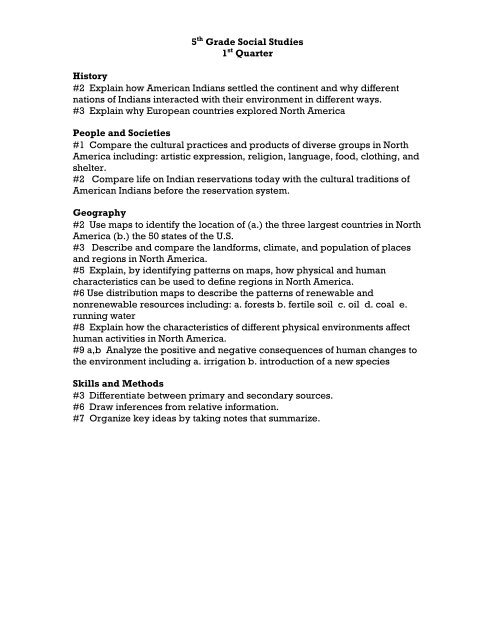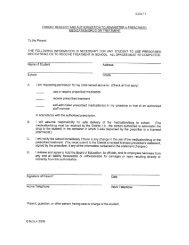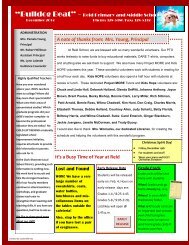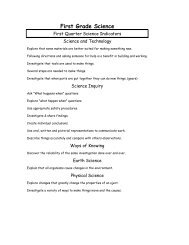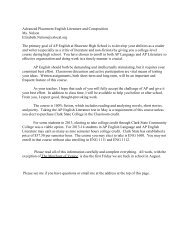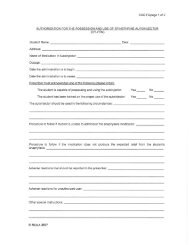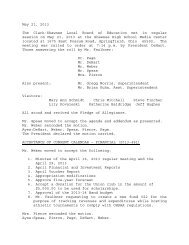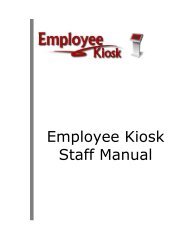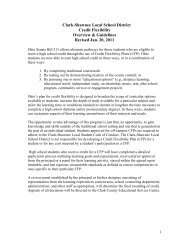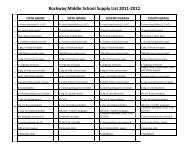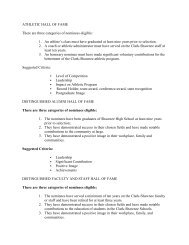Social Studies
Social Studies
Social Studies
You also want an ePaper? Increase the reach of your titles
YUMPU automatically turns print PDFs into web optimized ePapers that Google loves.
5 th Grade <strong>Social</strong> <strong>Studies</strong>1 st QuarterHistory#2 Explain how American Indians settled the continent and why differentnations of Indians interacted with their environment in different ways.#3 Explain why European countries explored North AmericaPeople and Societies#1 Compare the cultural practices and products of diverse groups in NorthAmerica including: artistic expression, religion, language, food, clothing, andshelter.#2 Compare life on Indian reservations today with the cultural traditions ofAmerican Indians before the reservation system.Geography#2 Use maps to identify the location of (a.) the three largest countries in NorthAmerica (b.) the 50 states of the U.S.#3 Describe and compare the landforms, climate, and population of placesand regions in North America.#5 Explain, by identifying patterns on maps, how physical and humancharacteristics can be used to define regions in North America.#6 Use distribution maps to describe the patterns of renewable andnonrenewable resources including: a. forests b. fertile soil c. oil d. coal e.running water#8 Explain how the characteristics of different physical environments affecthuman activities in North America.#9 a,b Analyze the positive and negative consequences of human changes tothe environment including a. irrigation b. introduction of a new speciesSkills and Methods#3 Differentiate between primary and secondary sources.#6 Draw inferences from relative information.#7 Organize key ideas by taking notes that summarize.
5 th Grade <strong>Social</strong> <strong>Studies</strong>2 nd QuarterHistory#1 Create time lines and identify possible relationships between events.#3 Explain why European countries explored and colonized North America.#4 Describe the lasting effects of Spanish, French, and English colonization inNorth America.People and Societies#3 Describe the experiences of African-Americans under the institution ofslavery.Geography#1 Use coordinates of latitude and longitude to determine absolute points inNorth America.#2 b, c, d Use maps to identify the location of the 50 states, the RockyMountains, and the Mississippi and Rio Grande Rivers.#3 Describe and compare the climate of places and regions in NorthAmerica#4 a, b, c Explain how climate is influenced by Earth-Sun relationships,landforms, and vegetation.#6 b, c Use distribution maps to describe the patterns of renewable andnonrenewable resources including: a. forests b. fertile soil c. oil d. coal e.running water#7 Analyze reasons for conflict and cooperation among regions including:trade.#8 Explain how different physical environments affect human activities inNorth America.#9 a, d Analyze the positive and negative consequences of human changes tothe environment including a. Great Lakes navigation d. Mining#10 Use or construct maps of colonization and exploration to explaininfluence in North America.Economics#2 Explain that individuals in all economies must answer the fundamentaleconomic questions of what to produce, how to produce, and for whom toproduce.#4 Explain how regions in North America become interdependent when theyspecialize in what they produce best and trade with other regions.#5 Explain the relationship between supply, demand, and price in acompetitive market.Skills and Methods#2 Locate information in a variety of sources using key words, relatedarticles, and cross reference.
#4 Read information critically in order to identify the author, the author’sperspective, and the purpose.5 th Grade <strong>Social</strong> <strong>Studies</strong>3 rd QuarterHistory#5 Explain how the United States became independent from Great Britain.#6 Explain the impact of settlement on the expansion of the U.S.People and Societies#3 Describe the experiences of African-Americans under the institution ofslavery.#4 Describe the waves of immigration to North America and the areas fromwhich people came in each wave.#5 Compare reasons for immigration to North America to the realityimmigrants experienced upon arrival.Geography#2 b, c, d Use maps to identify the location of the 50 states, the AppalachianMountains, and the St. Lawrence River.#4c Explain how climate is influenced by: vegetation.#5 Explain by identifying patterns on maps, how physical and humancharacteristics can be used to define regions in North America.#7 b, c Analyze reasons for conflict and cooperation among regions of NorthAmerica including: b. Environmental issues c. ImmigrationEconomics#3 Explain how education, specialization, capital goods, and the division oflabor affect productive capacity.#6 Explain why competition among producers/sellers results in lower costsand prices, higher product quality, and better customer service.#7 Explain why competition among consumers/ buyers results in higherproduct prices.Government#1 a,b,c Explain major responsibilities of each of the three branches ofgovernment: legislative, executive, and judicial.#2 a-e Explain the essential characteristics of American democracy.#3 Explain the significance of the Declaration of Independence and the U.S.Constitution.Citizenship Rights and Responsibilities#1 Explain how an individual acquires U.S. citizenship: a. birth b.naturalization#2 a-d Explain the obligations of upholding the U.S. Constitution.
#3 a-d Explain the significance of the rights that are protected by the FirstAmendment (Freedom of religion, speech, press, right of petition, andassembly)Skills and Methods#9 a-g Use a problem-solving/decision making process.#6 Draw inferences from relevant information5 th Grade <strong>Social</strong> <strong>Studies</strong>4 th QuarterHistory#6 Explain the impact of settlement, industrialization and transportation onthe expansion of the United States.People and Societies#4 Describe the waves of immigration and the areas from which people camein each wave.#5 Compare the reasons for immigration to North America with the realityimmigrants experienced upon arrival.Geography#9 b Analyze the positive and negative consequences of human changes tothe environment including b. highway systemsEconomics#1 Compare different allocation methods for scarce goods and services.Citizenship Rights and Responsibilities#1 Explain how an individual acquires U.S. citizenship: a. birth b.naturalization#2 a-d Explain the obligations of upholding the U.S. Constitution.#3 a-d Explain the significance of the rights that are protected by the FirstAmendment.Skills and Methods#1 a, b Obtain information from a variety of print and electronic sources andanalyze its reliability.#6 Draw inferences from relevant information


